I always enjoy photographing redheads, be they human or avian…
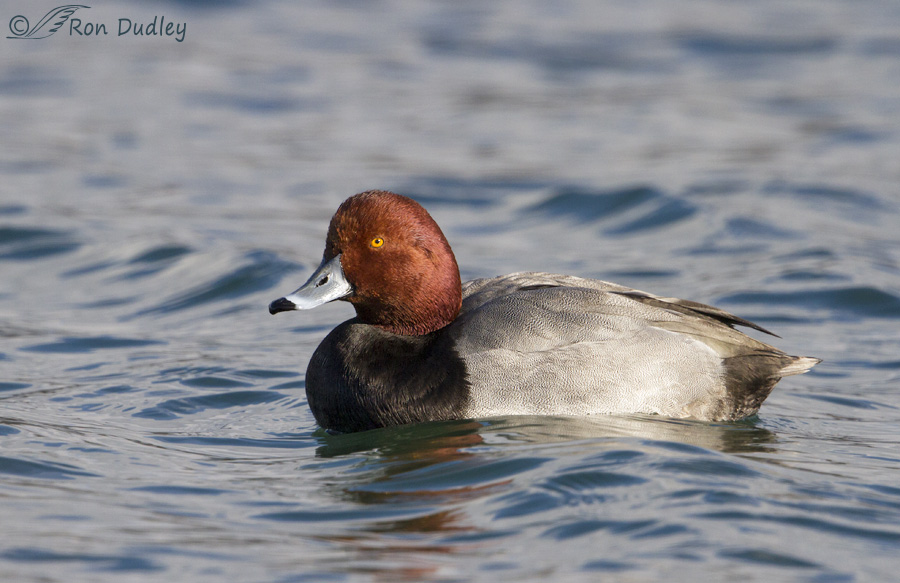
1/2500, f/6.3, ISO 500, Canon 7D, Canon EF 500mm f/4L IS II USM + EF 1.4 III Extender, not baited, set up or called in
Yesterday morning I found three male Redheads foraging on a pond near my home. It was nice to see these wild ducks there among all the Mallard hybrids, geese and coots. I think Redhead males are one of the more handsome of the ducks and in this image I like the way the bird is sitting at the top of a wind-caused swell in the water which revealed a little more of the bird’s body than we might normally see.
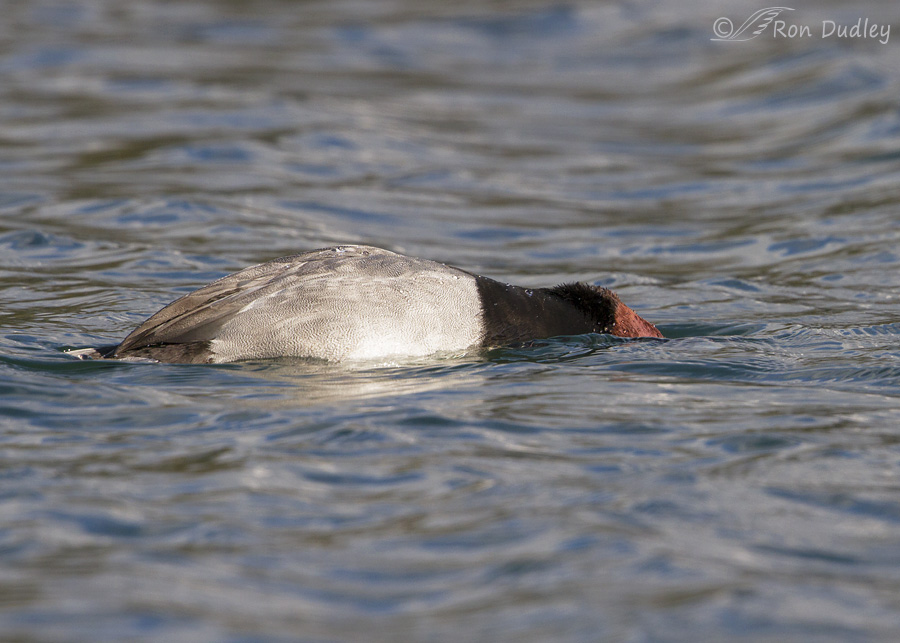
1/2500, f/6.3, ISO 500, Canon 7D, Canon EF 500mm f/4L IS II USM + EF 1.4 III Extender, not baited, set up or called in
The water was shallow and this duck would often put its head underwater to scope out the food prospects on the bottom before diving.
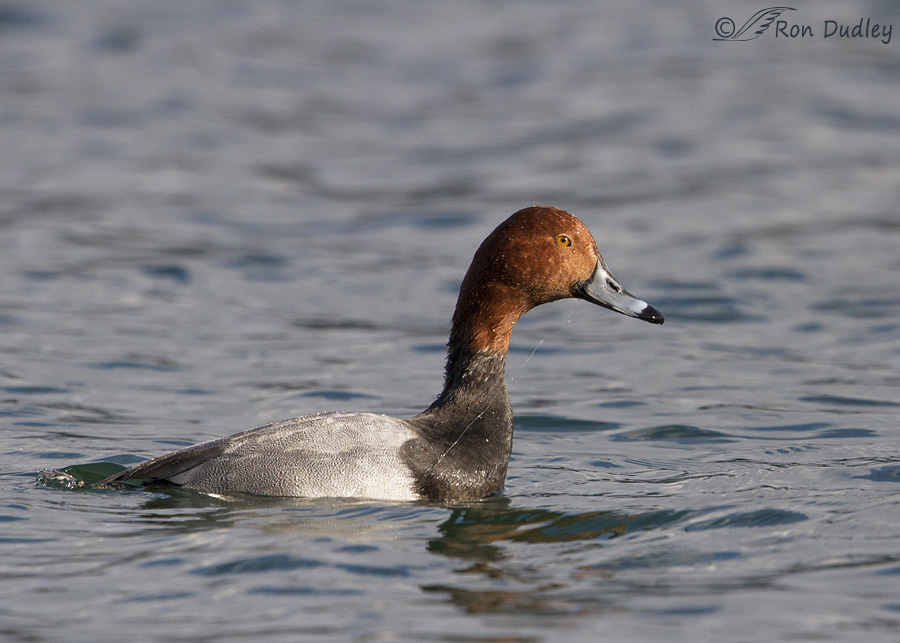
1/3200, f/6.3, ISO 500, Canon 7D, Canon EF 500mm f/4L IS II USM + EF 1.4 III Extender, not baited, set up or called in
Redheads are extremely buoyant which makes submerging a challenge so just prior to diving this bird would stretch its neck way up before…
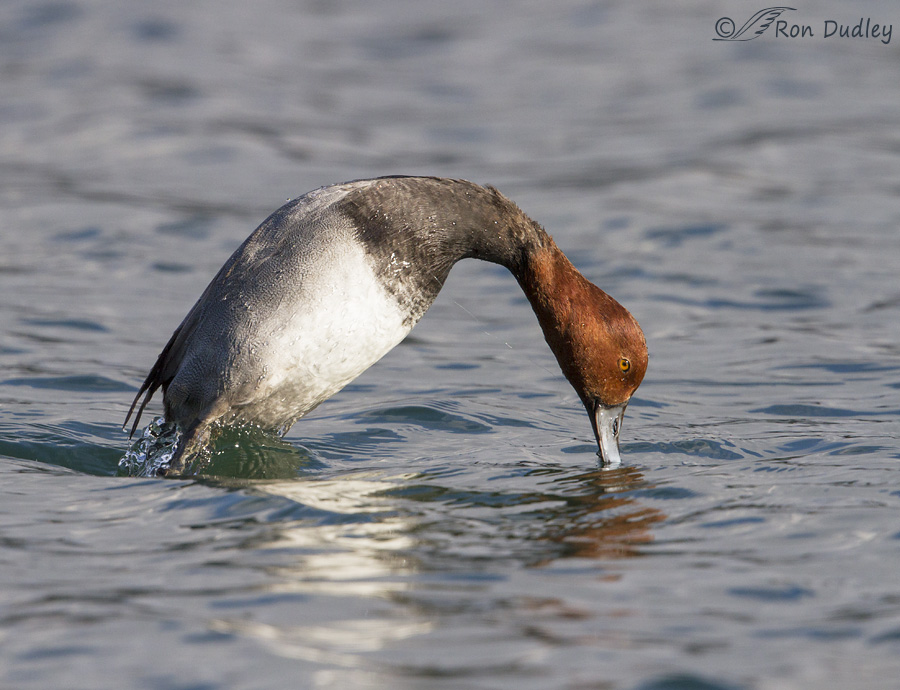
1/2500, f/6.3, ISO 500, Canon 7D, Canon EF 500mm f/4L IS II USM + EF 1.4 III Extender, not baited, set up or called in
pushing upwards against the water with its webbed feet in order to elevate more of its mass and give it more momentum as its curved body…
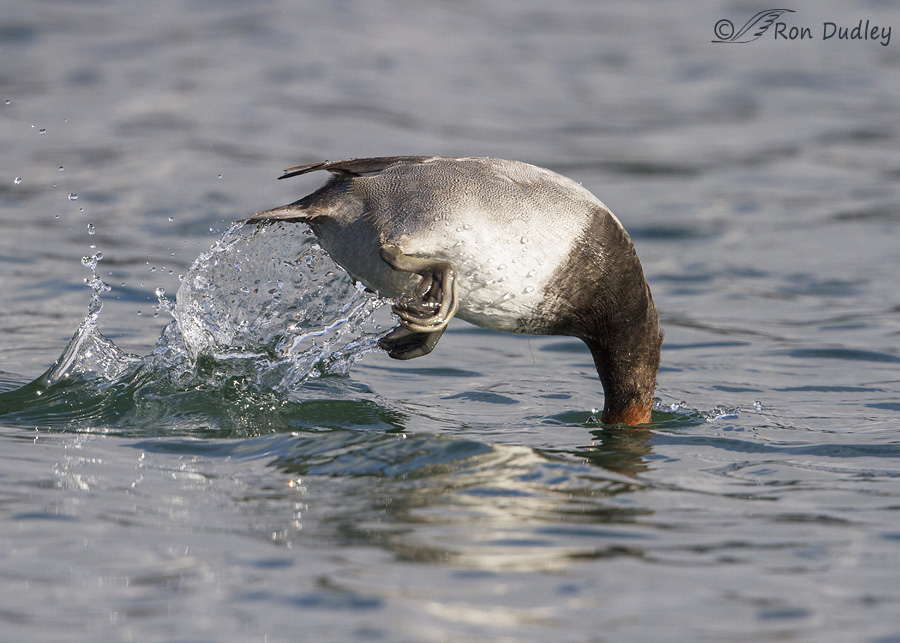
1/3200, f/6.3, ISO 500, Canon 7D, Canon EF 500mm f/4L IS II USM + EF 1.4 III Extender, not baited, set up or called in
re-entered the water. This strategy, along with breathing out (expiration) to reduce buoyancy just prior to the dive, allows these ducks to reach the bottom (and stay there for a few moments) with less energy expenditure than would otherwise be required.
I’m fascinated by behaviors and survival strategies and I’ll photograph them any chance I get. Hopefully these three Redheads will stick around until the pond freezes over (if it ever does…).
Ron
Notes:
- On Facebook there’s been some speculation that this duck has been entangled in fishing line as a thin filament can be seen between its head and chest if you look very carefully at the last three images. I don’t believe it’s fishing line. I suspect it’s something else, perhaps stringy mucus or filamentous algae? This is something I see often in diving ducks. I went back and checked over 100 other images of this bird and didn’t see it again.
- Due to apparent and inappropriate file caching by Comcast I’m having formatting problems that make my blog appear differently to me than it does to other viewers. So if you notice any formatting problems on your end (including photos that won’t load for you) please let me know in a comment. Thank you.


Late to the party, Ron, but what a series! Spectacular!
I’m glad you liked it Diane. Thanks.
Wonderful series Ron!
charlotte
Thanks, Charlotte.
WHAT a series. Love it.
And am smiling all over my face as I scroll up and down, up and down.
And yes, Laura is not alone in longing for feathers. And flight…
Personally, if I had my druthers, I’d prefer flight without feathers if at all possible. Feathers are too much work to maintain and I don’t think I’d enjoy the long drawn out process of molting…
I don’t know Ron. There seems to be a high level of peace while preening. I like that. And flight…yes, absolutely flight. The more I hang out with the birds the less I like this human engineering design. Just two hands/legs. That’s not even close to sufficient
Ok, Laura. I’ll come back at ya again with another thing to consider – average life span of raptors vs humans…
Good point Ron, however, there’s still that flight thing and if you manage to be a falconry bird, life’s a whole lot easier AND you still get to do really cool raptor things just like a wild raptor.
I agree, Laura. Flight is such an overwhelmingly strong point that for me it would outweigh a whole slew of negatives.
Yeah, this gravity thing is often annoying
AKA Canvasback?
They look a lot alike, Gary, but Canvasbacks have a whiter body, their bills are black and their heads are a darker red. The actual common name of this species really is “Redhead”.
My husband likes red heads, he often says that’s what attracted him to me, and to his delight both of our children inherited the gene.
Wonderful series of photos. After seeing the third photo I got all worked up about the fishing line. After reading your addendum at the end I had to go back and relax and enjoy the photos without distraught by “fishing line”. I love the last shot!
Your website pulled up fine for me today but Mia’s will not.
Thank you, April. I’ll let Mia know.
Once again, you nailed it! What a spectacular series–and I’m with you. I don’t think that’s fishing line.
I don’t often get to see redheads, but it’s a delight when I do…and what a terrific series of shots showing how they overcome the natural buoyancy of those incredibly dense feathers. I love feathers. I’d really like to have a bunch of them, and the incessant down from molting raptors that’s seemingly always stuck on me somewhere doesn’t count! While decorative (along with the dog hair), I can’t yet achieve flight…harrumph!
Ha, I now have an image of you covered in feathers and hair, Laura – a mammavian (mammal + avian) delight!
Thanks for the feedback on your opinion of what that “filament” is, or is not. I agree.
I love the one where he is pushing up just before diving. You really know how to get the story in one shot (I know it’s a lot of shots but you manage to get that “one” a lot. Or so it seems. So I like it. )
)
Agreed, Arwen – that shot tells a big part of the story all by itself. Thanks.
This is a wonderful sequence. I love seeing what goes into this guy’s dive. I had to zoom in to see the filament you mentioned, and am glad you think it’s not fishing line.
Thank you, Susan.
I had the experience of trying to catch a buffel head diving at our local irrigation pond. His flattening of his head feathers was his signal that he was about to dive. I got some great shots of his head partially submerged, but I didn’t have quite enough shutter speed to catch him without a little blur. Now I know why. I needed to shoot at 1/253200. I didn’t realize the 7d was so fast. Guess I need to get one.
Great shots btw.
Ha, thanks for pointing out my typo on the shutter speed, Frank! And for doing it in an entertaining way. I’ve corrected it.
And I’ll return the favor by correcting your typo in the word “shots” in your comment. Almost hate to do it though because your single letter typo was a helluva lot more fun than mine was!!!
Interesting series, especially the last. Sure hope that is NOT fishiing line…too often is…..
Thank you, Patty. I’m almost positive it isn’t.
Thanks for mentioning the filament-or-not seen in some of these photos. I noticed it and was going to ask. I’m glad to hear that you think it is something natural. Goodness knows there are plenty of creatures that swallow fishing hooks and lines; I’m really happy that is not the case here. Love the images -I have seen a redhead exactly once and hope to see more sometime.
Nancy, there are plenty of fishermen on that pond and they’re very careless with fishing line but I really don’t think that’s what it is. I’ve photographed other birds on this pond that have become entangled in line and it looks different from what we see in these images.
I saw that “filament” too, and wondered about it–I hope you’re right, and that it’s of natural origin………that Redhead is is just a gorgeous critter, and I’m seeing one for the first time—thanks !
I don’t see them very often either, Kris.
Some folks don’t like Redheads because they’re brood parasites but I certainly don’t fault them for that because it’s a natural behavior.
What a terrific behavioral series of these handsome ducks, Ron!! The last capture where this red head’s whole body has levitated just to be able to get it’s head underwater for food made me say “Wow” right out loud!! I can understand why you look forward to time with these ducks!! Just WOW!!!
I think that’s a fun shot too, Jo Ann. Thanks.
Great sequence, wonderful shots.
These shots really shows how delicate and light gray the vermiculation is on the sides of the Redhead. Vermiculation, for me, is very time consuming to paint on a carving..
Thanks for sharing!
I can only imagine how detailed and difficult that would be, Dick. Thank you.
new word to look up and add to my vocabulary!
On behalf of those of us who happen to be a bit more buoyant (ahem!) than the norm, I can say that I really like this duck’s style! Another really cool behavioral series, Ron! Love the color of those heads.
Your comment brought a grin this morning, Marty. Thanks for that!
Beautiful and fun sequence, Ron. The first picture really captures the “red head” while the rest document behavior. Like the little leap out of the water to dive in.
Thank you, Judy.